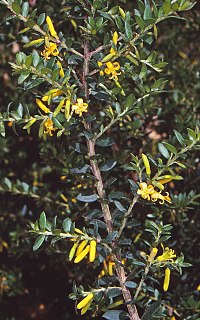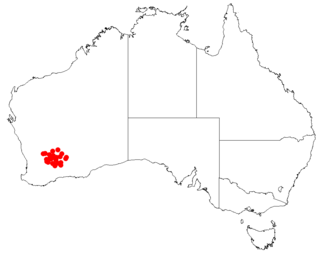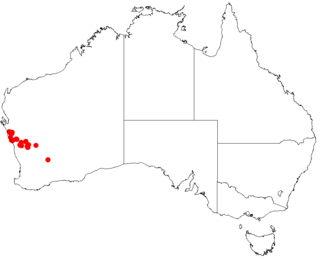
Lomatia tasmanica, commonly known as King's lomatia, is a shrub of the family Proteaceae native to Tasmania. Growing up to 8 metres (26 ft) tall, the plant has shiny green pinnate (lobed) leaves and bears red flowers in the summer, but yields neither fruit nor seeds. King's lomatia is unusual because all of the remaining plants are genetically identical clones. Because it has three sets of chromosomes and is therefore sterile, reproduction occurs only vegetatively: when a branch falls, that branch grows new roots, establishing a new plant that is genetically identical to its parent.

Persoonia, commonly known as geebungs or snottygobbles, is a genus of about one hundred species of flowering plants in the family Proteaceae. Plants in the genus Persoonia are shrubs or small trees usually with smooth bark, simple leaves and usually yellow flowers arranged along a raceme, each flower with a leaf or scale leaf at the base. The fruit is a drupe.

Persoonia chamaepitys, commonly known as the prostrate- or mountain geebung, is a shrub endemic to New South Wales in eastern Australia. It has a prostrate habit, reaching only 20 cm (7.9 in) high but spreading up to 2 m (6.6 ft) across, with bright green spine-like leaves and small yellow flowers appearing in summer and autumn.

Persoonia glaucescens, commonly known as the Mittagong geebung, is a species of flowering plant in the family Proteaceae and is endemic to New South Wales. It is an erect shrub with smooth bark, hairy young branchlets, lance-shaped leaves with the narrower end towards the base, and yellow flowers. It is the only persoonia in eastern Australia with strongly glaucous leaves.

Persoonia bargoensis, commonly known as the Bargo geebung, is a species of flowering plant in the family Proteaceae and is endemic to a restricted area of New South Wales. It is an erect shrub with linear to lance-shaped leaves, yellow, tube-shaped flowers and green, pear-shaped fruit.

Persoonia gunnii is a species of flowering plant in the family Proteaceae and is endemic to Tasmania. It is an erect shrub with young branchlets that are hairy at first, spatula-shaped to egg-shaped leaves with the narrower end towards the base, and white to cream-coloured flowers.

Persoonia muelleri, commonly known as Mueller’s geebung, is a shrub endemic to Tasmania. It forms a shrub in open areas of wet forests in the west and northeast of the state. It is occasionally confused with P. gunnii though it has larger flowers and longer, straighter leaves.

Persoonia elliptica, commonly known as snottygobble or spreading snottygobble, is a plant in the family Proteaceae and is endemic to the south-west of Western Australia. It is an erect shrub or small tree with egg-shaped or lance-shaped leaves and groups of cylindrical yellow flowers. It usually grows in woodland or forest dominated by jarrah or marri within 50 km (30 mi) of the coast.

Agastachys odorata, commonly known as the white waratah, is the sole member of the genus Agastachys in the protea family. It is an evergreen shrub to small tree and is endemic to the heaths and button grass sedgelands of western Tasmania. It occurs most often in moist heath and scrub and occasionally in the alpine regions, but generally prefers well-drained but poor soils. It can grow in some rainforests where it forms a small tree but is normally a shrub in all other situations. The heaviest concentrations are along the island's south coast. Its leaves are dark green, hairless and almost succulent. Masses of white flowers are produced in erect spikes from the ends of the branches. Measuring 8 to 12 cm high, they appear in January and February.

Persoonia asperula, commonly known as mountain geebung, is a plant in the family Proteaceae and is endemic to south-eastern Australia. It is an erect or prostrate shrub with smooth bark, mostly elliptic to oblong leaves and yellow flowers borne singly or in groups of up to nine. It mostly occurs in the Southern Highlands of New South Wales. A small population in Victoria may be a different species.
Persoonia pertinax is a species of flowering plant in the family Proteaceae and is endemic to Western Australia. It is an erect to spreading shrub with hairy young branchlets, twisted linear leaves, and hairy yellow flowers borne in groups of up to ten on a rachis up to 60 mm (2.4 in) long.

Persoonia inconspicua is a species of flowering plant in the family Proteaceae and is endemic to the south-west of Western Australia. It is an erect, often spreading shrub with branchlets and leaves that are densely hairy when young, linear leaves and relatively small greenish yellow flowers usually borne singly or in pairs.

Persoonia graminea is a species of flowering plant in the family Proteaceae and is endemic to the south-west of Western Australia. It is an erect to weak, low-lying shrub with long, linear leaves and flowers in groups of ten to twenty-five on a rachis up to 220 mm (8.7 in) long.

Persoonia hexagona is a species of flowering plant in the family Proteaceae and is endemic to the south-west of Western Australia. It is an erect, spreading shrub with branchlets that are densely hairy when young, linear, sharply pointed leaves and bright yellow, hairy flowers borne singly or in groups of up to ten on a rachis up to 40 mm (1.6 in) long.
Persoonia bowgada is a species of flowering plant in the family Proteaceae and is endemic to the south-west of Western Australia. It is an erect to spreading shrub with smooth bark, more or less cylindrical leaves and yellow flowers in groups of up to ten on the ends of branches.
Persoonia papillosa is a species of flowering plant in the family Proteaceae and is endemic to a restricted area in the west of Western Australia. It is a small, erect shrub with hairy young branchlets, linear leaves with six prominent parallel veins, and hairy flowers borne in groups of up to twenty on a rachis up to 60 mm (2.4 in) long.

Persoonia filiformis is a species of flowering plant in the family Proteaceae and is endemic to the south-west of Western Australia. It is a small, erect shrub with hairy young branchlets, linear leaves and greenish yellow flowers borne singly or in groups of up to twenty on a rachis up to 30 mm (1.2 in) long.
Persoonia biglandulosa is a species of flowering plant in the family Proteaceae and is endemic to the south-west of Western Australia. It is an erect, spreading or low-lying shrub with smooth bark, linear leaves and bright yellow flowers in groups of between eight and twenty-five on the ends of branches.

Persoonia stricta is a species of flowering plant in the family Proteaceae and is endemic to the south-west of Western Australia. It is an erect, spreading shrub with smooth bark, linear to spatula-shaped or oblong leaves, and bright yellow flowers borne in groups of four to twenty-five on a rachis 3–100 mm (0.12–3.94 in) long, each flower with a leaf or scale leaf at its base.

Persoonia teretifolia is a species of flowering plant in the family Proteaceae and is endemic to the south-west of Western Australia. It is an erect, spreading shrub with smooth bark, hairy young branchlets, linear leaves, and bright yellow flowers borne in groups of up to twenty on a rachis up to 100 mm (3.9 in) long that continues to grow after flowering.















